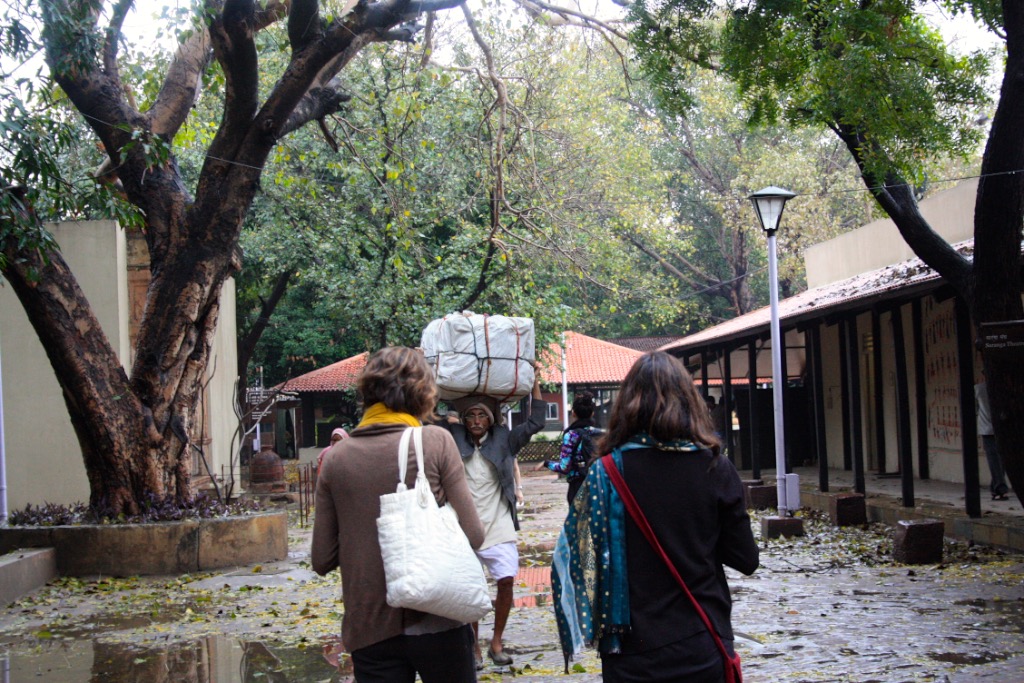Why Gurus Wear Scarves (and the occasional neck brace) // a visit to The Old Prayer in India
Hailey Fynaardt
Last week I wrote about how I find product for the Habitation Co. shop, which sometimes looks like having an hour-long conversation with a woman wearing a neck brace, in her tiny shop in a hotel lobby in New Delhi, India...
On the very last day of our two-week trip in India, my friend Erica, and I were meeting a few of the remaining girls from our group for lunch before departing on our long journeys home. One of the girls had just visited "The Old Prayer", the little boutique in the back corner of our hotel lobby, and was wearing the prettiest scarf that she had just purchased there. When Erica and I told her we were planning on stopping by, she asked if we could take a photo of the shop keeper for her.
We step into the shop, a narrow room with a long rack of pastel cotton tunics and dresses along one wall, and pink floral wall paper along another. In the back, at her small desk, is Mrs. Singh, the shop keeper. Effortlessly chic in a silk jacket, chignon bun, and velcro neckbrace, she stands up to greet us. After a few minutes of browsing around the job, Erica asks Mrs. Singh if we could take a photo of her, explaining that it was for a friend who had visited earlier. Though baffled as to why these American girls would want a photo of or with her, and slightly self-conscious of the foam brace around her neck, she politely agreed. After a few minutes, we had gotten our photo and were ready to pick out a scarf and be on our way, but Mrs. Singh had other plans for us.
Erica, Mrs. Singh, and her neckbrace
One of us must have asked Mrs. Singh about the neckbrace (probably Erica, she asks about those things) and I believe her answer was along the lines of "the normal aches and pains of aging". But before we knew it, she was telling us a very personal story- about the premature loss of her father, husband, and son, and how she has since found peace, and even happiness despite her grief. "We must be worthy of our misfortunes", she explained, that loss and mourning is just as much a part of life as our blessings, and that they can teach us something if we are willing to learn.
At this point, Erica was in tears, and I was silently holding my cell phone camera as still as possible on the other side of the room, but Mrs. Singh had only gotten started. "India loves when white girls come to visit!" she continued, "because they are always looking for something- some answer, something outside of ourselves". Yes, we often believe that some Guru in a remote village has the secret to our happiness, or purpose, in life, and we have to fly to the opposite side of the world and eat a lifetime's worth of curry, to find it.
Mrs. Singh's take on these "gurus"? "What? They don't know shit!" she claims. She has our full attention now.
"What do they (gurus) know?! They've never done anything, been anywhere. YOU are the gurus, you are ones who are doing things, trying new things..." she continued. New "things" like leaving our homes and lives 12,000 miles away to travel in a foreign land with a group of strangers. New things like starting businesses, forging relationships, and learning new skills. New things that rip us out of our comfort zones, stretch us, test us, and challenge us. This is how we grow, this is where our "answers" are.
In the end, yes, we each bought a scarf as planned, but left that little shop with so much more. It was truly the best way to end our two-week journey. Also the best? Spending our last hours in Delhi exploring the Gandhi Museum and having tea in the garden of our hotel. Followed by a delicious dinner (of chow mein, because enough with the curry already.) And the hour-long massages we opted for before taking a late night taxi to the airport where we had one last drink ("sweet lime") with one of our incredible hostesses Lisa before boarding our separate flights... Really, the last day of our trip was, in every way, just as amazing as all of the others.
Last year, as I was preparing to order products for the shop, I knew that I needed to find a way to carry some of these "Old Prayer scarves". After a few months of sending Facebook messages and emails back and forth I received my first order of scarves last fall. I named each scarf for one of the amazing women I spent those two weeks in India with. Several have already been snatched up but there are still plenty of styles in the shop.
When the first set of scarves started to sell out (and I started getting asked about when a new order would be coming!), I began the process of re-ordering and I am so excited to share that our new shipment has arrived!! Twelve more of these beauties will be making their way to the shop in the next week or so.
the new scarves! watch for them in the shop soon!
The internet, photos, and my words cannot do these scarves justice but trust me when I say that they are the most beautiful and unique (truly one-of-a-kind!) scarves I have ever seen. They are soft, and light weight, and versatile, and high quality- made from the softest fabrics and finished with unique details like little hand-sewn buttons and seashell tassels. They are also big because what use is a tiny scarf. These scarves are easy to wear and seriously perfect for all weather, year-round, and can easily be layered over a dress, t-shirt, or sweater.
I mean, look, they are scarves- you know how they work. I'm not here to tell you why scarves are fun- you probably already know that. What I am here to do is share stories about things that have been made with love and skill by people who value the same things as you and I. Not only do these scarves remind me of people like Mrs. Singh, the "gurus" I already know, and the interesting places I've visited- they are also just really beautiful. and comfortable. and high quality. and unique and something you probably need at least one of in your life.
But what do I know, I'm just a guru.
Enjoy the process!
Hailey




































